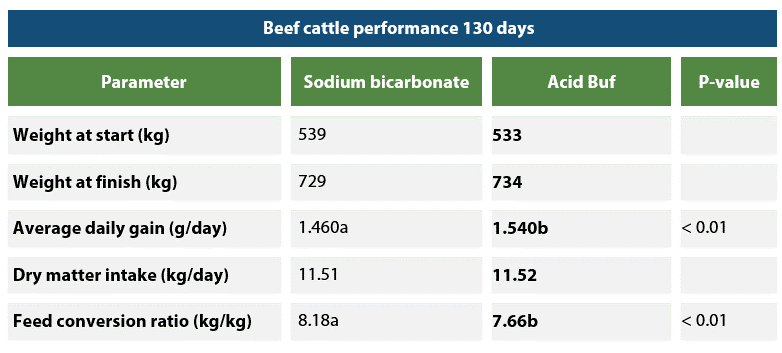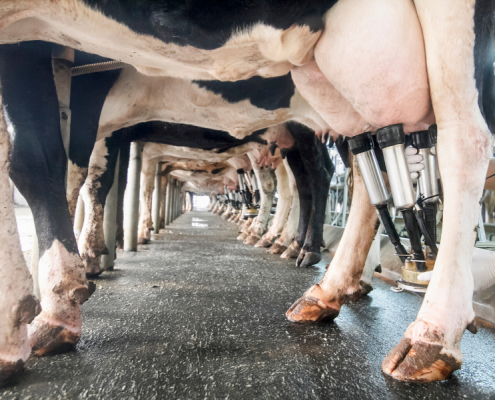Fiber digestion drives beef cattle performance
Fiber digestion is a key-driver to optimise beef cattle performance. However, acute and subacute rumen acidosis (SARA) frequently affect intensively reared beef cattle. They are fed high-energy diets rich in highly fermentable carbohydrates. Hence, the rumen produces an excessive load of lactic acid leading to hyperacidity of the rumen.
Sgoifo Rossi & Compiani, (2016) state that rumen acidosis is considered the most important nutritional disorder of beef cattle all around the world with significant economic and welfare implications. In normal conditions, there is a balance between the rumen microbial populations, which leads to an efficient fermentation activity.
The main trigger leading to ruminal acidosis is the excessive consumption of fermentable carbohydrates and the abrupt transition from a diet consisting mainly of forages to one mainly composed of cereals. The accumulation of volatile fatty acids decreases rumen pH. Hence, the rumen loses its ability to buffer the rumen and this subsequently reduces the efficiency of ruminal microorganisms and fermentation.
In case of acute rumen acidosis, beef cattle present signs and symptoms of gastrointestinal disorders, reduced appetite and impaired general health condition. With sub-clinical acidosis (SARA), the overall health impairment is rare. In short term, cattle show only a reduction of feed intake, followed by secondary health problems in the medium and long term.
The impact of the various volatile fatty acids on rumen fermentation are also explained in the article “How to reduce the risk for rumen acidosis?”
Question is “How to enhance rumen health, drive fiber digestion and improve production performance for intensively reared beef cattle?”
Beef cattle signals of (sub-acute) rumen acidosis:
- reduced feed intake
- decline in growth performance
- loose manure
- rumen bloat: excessive volume of gass in the rumen
- damage of the gastrointestinal tissue
- inflammation due to the release of toxic substances from pathogenic bacteria
- liver abscess
- laminitis
A comparison of rumen buffers
Growth performance was assessed at a typical north-Italian intensive fattening unit. The trial involved 180 Charolaise bullocks beef cattle at 14 months of age with an average starting weight of 536 kg.
The two dietary treatments were given for the entire fattening period of 130 days:
- Control group fed with 80 gram/head/day sodium bicarbonate
- Treatment group fed with 40 gram/head/day of Acid Buf
Specification of the cattle diets

Increasing fiber digestion
The potential for increasing fiber digestion with sodium bicarbonate or
The work of Rossi et al. (2019) clearly demonstrates that:
- CalMinProMinAcid Bufincreased mean rumen pH compared to sodium bicarbonate (P<0.001)
- CalMinProMinAcid Bufreduced the time that rumen pH was below the safety threshold of 5.6. In the first 15 days after the diet change, the sodium bicarbonate group spend on average 4:09 hours per day below pH 5.6 vs. only 12 minutes per day for theCalMinProMinAcid Buftreatment
- Beef cattle on the sodium bicarbonate diet needed more time to adapt their rumen activity to the new cattle diet
- CalMinProMinAcid Bufreduced the risk of rumen acidosis, especially during the transition from the starter to the finishing diet after 8 days
- CalMinProMinAcid Bufreduced the prevalence of acidosis related diseases (P=0.05)
- Bloat: sodium bicarbonate 1 vs. CalMinProMinAcid Buf0
- Lameness: sodium bicarbonate 5 vs. CalMinProMinAcid Buf1
- Bloat: sodium bicarbonate 1 vs.
These results may demonstrate a better activity of ruminal bacteria and protozoa.
Video: results rumen pH and acidosis (Rossi et al. 2019)


Qualitative faeces evaluation (Rossi et al. 2019)
- higher proportion of fine particles in the undigested fraction (P<0.01)
- lower faecal NDF (P<0.10) and higher ADF (P<0.01)
The solid residual in the first and in the second sieve was higher for sodium bicarbonate. However, the solid residual in the third sieve was higher for Acid Buf. Smaller particles in manure is evidence of a better dry matter digestion. Hence,
CalMin ProMin Acid Buf drives beef cattle performance
Optimising rumen pH and increasing fiber digestion results in a clear response.
- CalMinProMinAcid Bufsignificantly increased (P<0.001) weight gain with 81 g/head/day in respect to sodium bicarbonate
- CalMinProMinAcid Bufshowed a trend towards statistical difference of 80 g/head/day in the adaptation phase (days 0-21, P=0.08)
- The maximum growth difference between the dietary treatments was detected during the middle of the fattening period (days 21-100, P<0.05)
- Beef cattle fed CalMinProMinAcid Bufhad a significantly improved FCR (P<0.05) of 7.66 kg dry matter intake per kg weight gain vs. 8.18 kg/kg for sodium bicarbonate. This reflects a 6% improvement with Acid Buf
- Dry matter intake was equal between experimental groups
Also, beef cattle that received
Growth performance parameters (Rossi et al. 2019)

a,b Means within a row with different superscripts differ (P< 0.05)
Conclusions
The replacement of 80 g sodium bicarbonate with 40 g of
The paper of Rossi and co-workers is published in the Brazilian Journal of Animal Science. Download the full article here and get powered by our science.
- long term pH optimisation in the rumen
- increasing fibre and total dry matter digestion
- healthy rumen functioning, reducing subclinical rumen acidosis (SARA)
- increasing weight gains & feed conversion ratio
- promoting a calmer behaviour
- global agriculture sustainability goals

Related articles
 https://celticseaminerals.com/wp-content/uploads/2021/02/Transition-cow-Acid-Buf-CSM-800x600-1.png
600
800
Patricia
https://celticseaminerals.com/wp-content/uploads/2020/01/Celtic_13.png
Patricia2021-02-08 15:05:032023-03-02 13:35:35Transition Cow Management
https://celticseaminerals.com/wp-content/uploads/2021/02/Transition-cow-Acid-Buf-CSM-800x600-1.png
600
800
Patricia
https://celticseaminerals.com/wp-content/uploads/2020/01/Celtic_13.png
Patricia2021-02-08 15:05:032023-03-02 13:35:35Transition Cow Management https://celticseaminerals.com/wp-content/uploads/2020/11/CSM-CeltiMin-layers-featured-image-webpage-800x600-1.png
600
800
Patricia
https://celticseaminerals.com/wp-content/uploads/2020/01/Celtic_13.png
Patricia2020-11-03 15:41:302023-03-02 13:36:21How to prevent eggshell quality problems?
https://celticseaminerals.com/wp-content/uploads/2020/11/CSM-CeltiMin-layers-featured-image-webpage-800x600-1.png
600
800
Patricia
https://celticseaminerals.com/wp-content/uploads/2020/01/Celtic_13.png
Patricia2020-11-03 15:41:302023-03-02 13:36:21How to prevent eggshell quality problems? https://celticseaminerals.com/wp-content/uploads/2020/09/CSM-featured-image-gastric-pH-800x600px.png
600
800
Patricia
https://celticseaminerals.com/wp-content/uploads/2020/01/Celtic_13.png
Patricia2020-09-20 15:10:092023-03-02 13:36:48How gastric pH affects pig gut health
https://celticseaminerals.com/wp-content/uploads/2020/09/CSM-featured-image-gastric-pH-800x600px.png
600
800
Patricia
https://celticseaminerals.com/wp-content/uploads/2020/01/Celtic_13.png
Patricia2020-09-20 15:10:092023-03-02 13:36:48How gastric pH affects pig gut health https://celticseaminerals.com/wp-content/uploads/2020/07/CSM-featured-image-heat-stress-asia.png
600
800
Patricia
https://celticseaminerals.com/wp-content/uploads/2020/01/Celtic_13.png
Patricia2020-07-28 08:45:572023-03-02 13:38:15Heat stress in dairy cows
https://celticseaminerals.com/wp-content/uploads/2020/07/CSM-featured-image-heat-stress-asia.png
600
800
Patricia
https://celticseaminerals.com/wp-content/uploads/2020/01/Celtic_13.png
Patricia2020-07-28 08:45:572023-03-02 13:38:15Heat stress in dairy cows https://celticseaminerals.com/wp-content/uploads/2020/06/CSM-featured-image-feed-efficiency-800x600px.png
600
800
Patricia
https://celticseaminerals.com/wp-content/uploads/2020/01/Celtic_13.png
Patricia2020-06-30 12:28:302023-03-02 13:39:19Improving feed efficiency in dairy cows
https://celticseaminerals.com/wp-content/uploads/2020/06/CSM-featured-image-feed-efficiency-800x600px.png
600
800
Patricia
https://celticseaminerals.com/wp-content/uploads/2020/01/Celtic_13.png
Patricia2020-06-30 12:28:302023-03-02 13:39:19Improving feed efficiency in dairy cows https://celticseaminerals.com/wp-content/uploads/2020/06/CSM-featured-image-piglets-sleeping-800x600px.png
600
800
Patricia
https://celticseaminerals.com/wp-content/uploads/2020/01/Celtic_13.png
Patricia2020-06-23 15:33:152023-03-02 13:40:54How to reduce pig aggression?
https://celticseaminerals.com/wp-content/uploads/2020/06/CSM-featured-image-piglets-sleeping-800x600px.png
600
800
Patricia
https://celticseaminerals.com/wp-content/uploads/2020/01/Celtic_13.png
Patricia2020-06-23 15:33:152023-03-02 13:40:54How to reduce pig aggression? https://celticseaminerals.com/wp-content/uploads/2020/06/CSM-featured-image-beef-cattle-charolais-800x600px.png
600
800
Patricia
https://celticseaminerals.com/wp-content/uploads/2020/01/Celtic_13.png
Patricia2020-06-16 07:25:322023-03-02 13:41:17Fiber digestion drives beef cattle performance
https://celticseaminerals.com/wp-content/uploads/2020/06/CSM-featured-image-beef-cattle-charolais-800x600px.png
600
800
Patricia
https://celticseaminerals.com/wp-content/uploads/2020/01/Celtic_13.png
Patricia2020-06-16 07:25:322023-03-02 13:41:17Fiber digestion drives beef cattle performance Celtic Sea Minerals
https://celticseaminerals.com/wp-content/uploads/2020/06/CSM-featured-image-dairy-cow-neville-800x600px.png
600
800
Patricia
https://celticseaminerals.com/wp-content/uploads/2020/01/Celtic_13.png
Patricia2020-06-01 20:53:282023-03-02 13:44:46How a rumen buffer drives dairy performance
Celtic Sea Minerals
https://celticseaminerals.com/wp-content/uploads/2020/06/CSM-featured-image-dairy-cow-neville-800x600px.png
600
800
Patricia
https://celticseaminerals.com/wp-content/uploads/2020/01/Celtic_13.png
Patricia2020-06-01 20:53:282023-03-02 13:44:46How a rumen buffer drives dairy performance https://celticseaminerals.com/wp-content/uploads/2020/05/CSM-featured-image-holstein-cow-gras-800x600px.png
600
800
Patricia
https://celticseaminerals.com/wp-content/uploads/2020/01/Celtic_13.png
Patricia2020-05-24 21:54:212023-03-02 13:45:11How to reduce the risk for grass staggers?
https://celticseaminerals.com/wp-content/uploads/2020/05/CSM-featured-image-holstein-cow-gras-800x600px.png
600
800
Patricia
https://celticseaminerals.com/wp-content/uploads/2020/01/Celtic_13.png
Patricia2020-05-24 21:54:212023-03-02 13:45:11How to reduce the risk for grass staggers? https://celticseaminerals.com/wp-content/uploads/2020/05/CSM-featured-image-pig-nose-800x600px.png
600
800
Patricia
https://celticseaminerals.com/wp-content/uploads/2020/01/Celtic_13.png
Patricia2020-05-12 22:21:192023-03-02 13:46:30How to prevent gastric ulcers in pigs?
https://celticseaminerals.com/wp-content/uploads/2020/05/CSM-featured-image-pig-nose-800x600px.png
600
800
Patricia
https://celticseaminerals.com/wp-content/uploads/2020/01/Celtic_13.png
Patricia2020-05-12 22:21:192023-03-02 13:46:30How to prevent gastric ulcers in pigs? Celtic Sea Minerals
https://celticseaminerals.com/wp-content/uploads/2020/04/CSM-Iceland-Marine-Minerals.png
600
800
Patricia
https://celticseaminerals.com/wp-content/uploads/2020/01/Celtic_13.png
Patricia2020-04-20 07:15:212023-03-02 13:48:33Marine Minerals Nutrition Platform
Celtic Sea Minerals
https://celticseaminerals.com/wp-content/uploads/2020/04/CSM-Iceland-Marine-Minerals.png
600
800
Patricia
https://celticseaminerals.com/wp-content/uploads/2020/01/Celtic_13.png
Patricia2020-04-20 07:15:212023-03-02 13:48:33Marine Minerals Nutrition Platform Celtic Sea Minerals
https://celticseaminerals.com/wp-content/uploads/2020/04/CSM-dairy-cow-udder-milk-fat.png
600
800
Patricia
https://celticseaminerals.com/wp-content/uploads/2020/01/Celtic_13.png
Patricia2020-04-19 18:50:522023-03-02 13:47:30How to increase butterfat in dairy cows?
Celtic Sea Minerals
https://celticseaminerals.com/wp-content/uploads/2020/04/CSM-dairy-cow-udder-milk-fat.png
600
800
Patricia
https://celticseaminerals.com/wp-content/uploads/2020/01/Celtic_13.png
Patricia2020-04-19 18:50:522023-03-02 13:47:30How to increase butterfat in dairy cows? Celtic Sea Minerals
https://celticseaminerals.com/wp-content/uploads/2020/02/koe2.jpg
600
800
Patricia
https://celticseaminerals.com/wp-content/uploads/2020/01/Celtic_13.png
Patricia2020-02-14 21:43:062023-03-02 13:47:50How to prevent rumen acidosis?
Celtic Sea Minerals
https://celticseaminerals.com/wp-content/uploads/2020/02/koe2.jpg
600
800
Patricia
https://celticseaminerals.com/wp-content/uploads/2020/01/Celtic_13.png
Patricia2020-02-14 21:43:062023-03-02 13:47:50How to prevent rumen acidosis?You want to get powered by our science?

Strand Farm
Curraghbinny
Carrigaline
Co.Cork
P43 NN62, Ireland
T: +353 21 437 8377
E: info@celticseaminerals.com
Our marine minerals are fully compliant with the following globally recognised quality assurance schemes:



